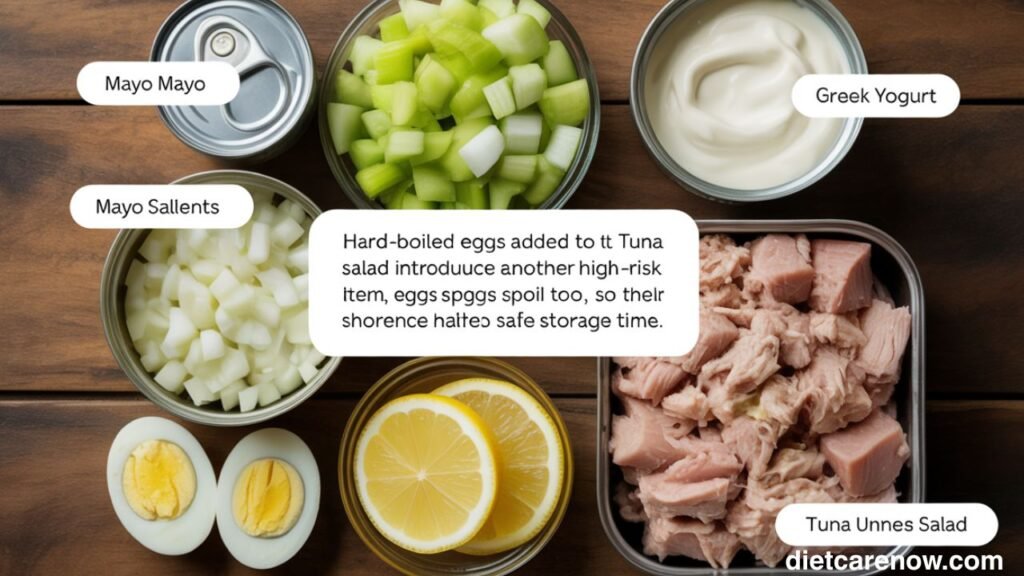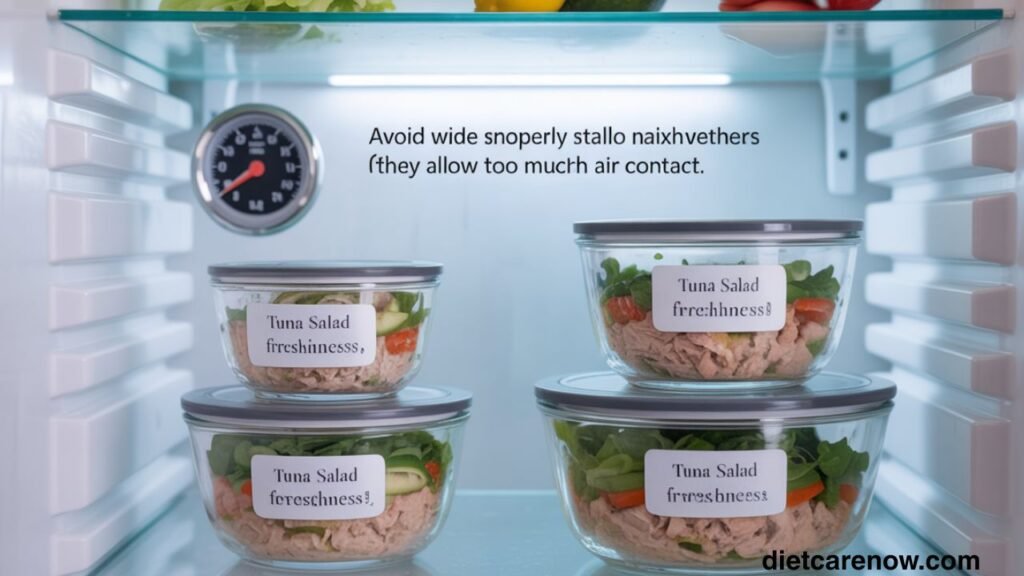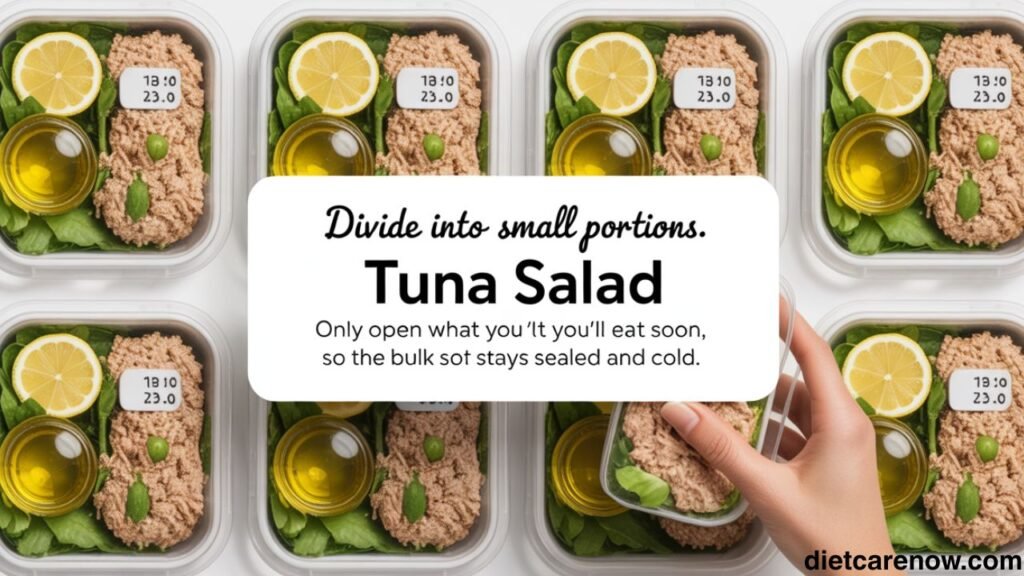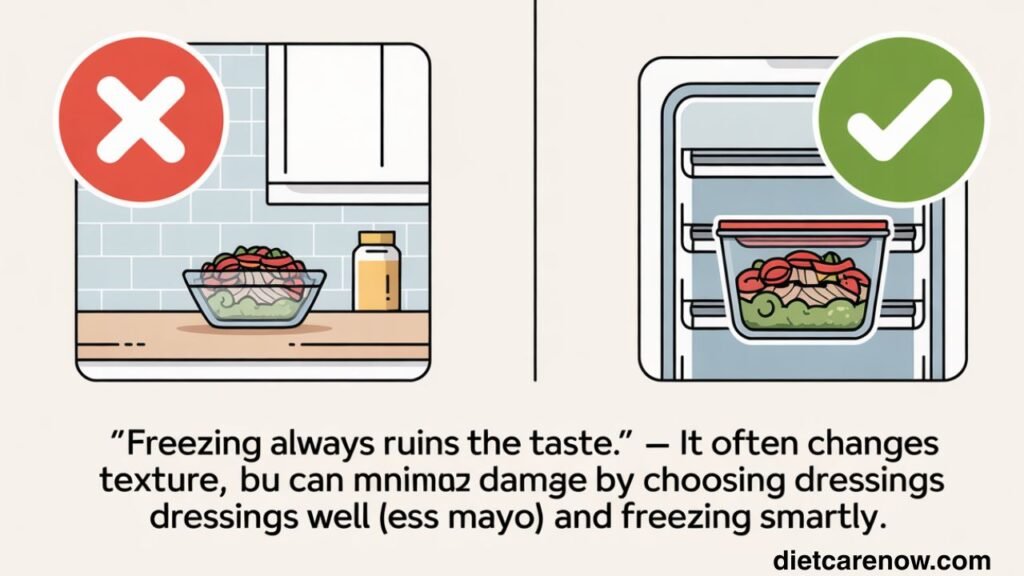Tuna salad is one of those easy, go-to dishes many of us depend on for a quick lunch or picnic spread. You mix cooked or canned tuna with dressings and add-ins—celery, onions, perhaps some hard-boiled egg—and you have something both versatile and satisfying. But here’s the catch: once you’ve assembled all those ingredients together, the clock is ticking on freshness and safety.
Knowing the shelf life of tuna salad is about more than avoiding a bad meal. It’s about protecting your health. Bacteria grow faster in mixed, perishable dishes, and some signs of spoilage aren’t obvious at first. In this article, I’ll walk you through everything you need: what affects storage time, safe handling practices, how to spot when it’s gone bad, and tricks to stretch freshness—without compromising safety.
Key Ingredients that Affect Tuna Salad Shelf Life
Not all tuna salads are created equal. Which ingredients you use can speed up or slow down spoilage. Let’s break it down.
The Role of Tuna (Fresh, Canned, or Pouch)
- Canned or pouch tuna is already cooked and shelf-stable until opened. Once opened and mixed, though, it behaves more like a perishable protein.
- Fresh (cooked) tuna used in gourmet variations adds more risk because it’s usually more delicate and has higher moisture—so spoilage can happen faster.
Mayo, Yogurt, or Dressing Types
- Mayonnaise-based dressings are common. Because mayonnaise is an emulsion of eggs and oil (often with vinegar, and sometimes with added dairy), it’s vulnerable to breaking, separation, or bacterial overgrowth once exposed to warm conditions.
- Yogurt-based dressings (often Greek yogurt) or dressings that include sour cream can be more unstable, especially in warm temperatures.
- Oil + vinegar dressings or lighter citrus/olive oil–based dressings tend to be more forgiving—less dairy, less risk of curdling or separation.
Fresh Ingredients (Celery, Onions, Eggs, etc.)
- Crunchy vegetables like celery, bell pepper, or onion bring water content and can become limp over time.
- Hard-boiled eggs added to tuna salad introduce another high-risk item. Eggs spoil too, so their presence shortens safe storage time.
- Delicate greens or herbs wilt and break down, releasing moisture that can degrade texture and encourage spoilage.
Also read: /lactose-free-cheese/

How Long Does Tuna Salad Last at Room Temperature?
This is one of the trickiest spots for food safety mistakes.
Food Safety Rules for Perishable Items
Perishable foods—especially those with protein, eggs, or dairy—should not be left at room temperature (typically 20–25 °C or higher) for extended periods. Bacteria grow quickly in what’s often called the “danger zone” (between ~4 °C and ~60 °C).
Dangers of Leaving Tuna Salad Unrefrigerated
Leaving tuna salad out allows harmful bacteria (like Salmonella, Listeria, or E. coli) to multiply. The longer it stays in that danger zone, the higher the risk of reaching levels that can make you sick.
The “Two-Hour Rule” Explained
The standard guideline: discard perishable food if it’s been out at room temperature for more than 2 hours. On hot days (say above 32 °C), reduce that to 1 hour. Once you pass that time, even if it looks and smells okay, it’s no longer safe.
Refrigerator Storage: How Long Tuna Salad Lasts in the Fridge
Refrigeration is your best friend when it comes to extending the life of tuna salad—but it won’t last forever.
Ideal Refrigeration Temperature
The safe temperature for perishable foods is 4 °C (40 °F) or below. Set your fridge to this range, and use a thermometer if needed to check.
Expected Shelf Life (3–5 Days)
According to official food safety charts (e.g. FoodSafety.gov), tuna salad (along with egg, chicken, or macaroni salads) is safe for 3 to 4 days in the refrigerator.Some sources and practical guides extend that by a day in ideal conditions (making it up to 5 days) .
“StillTasty” and others confirm 3–5 days as a realistic window.
Signs It’s Nearing Spoilage
Even within that window, quality declines. Watch for:
- Liquid separation: Dressings may separate and appear watery.
- Soft or slimy textures: Ingredients lose their firmness.
- Darkening or discoloration: Tuna, mix-ins, or dressing may change color.
- Off odors: A sour, tangy, or rotten smell.
Freezing Tuna Salad: Is It Safe or Recommended?
Freezing seems like an easy fix, but it comes with caveats.
Can Tuna Salad Be Frozen Safely?
From a strict safety perspective, yes—if the entire salad is frozen quickly and consistently at 0 °F (−18 °C). But food safety charts often note that tuna salad “does not freeze well” for quality reasons.
How Mayo-based vs. Non-mayo Recipes React
- Mayo-based salads: The emulsion (egg, oil, water) tends to break when thawed—leading to separation and a grainy or watery texture.
- Oil-based or vinegar dressings survive better because there’s less dairy and fewer unstable ingredients.
- Salads with crunchy vegetables: These lose texture and become mushy after thawing.
Best Practices for Thawing Frozen Tuna Salad
If you do freeze, follow these steps:
- Store in a tightly sealed, freezer-safe container (leaving a little headspace for expansion).
- Label with date.
- Thaw in the refrigerator (slow thaw), not at room temperature.
- Stir gently to re-emulsify if possible.
- Consume promptly once thawed—do not refreeze.
How to Properly Store Tuna Salad for Maximum Freshness
Here’s how to give your tuna salad the best chance at lasting through those few safe days.
Choosing the Right Airtight Containers
- Prefer glass containers (nonreactive, easy to clean) or high-quality BPA-free plastic containers.
- Make sure lids seal tightly to limit air exposure.
- Avoid wide shallow bowls covered with plastic wrap—they allow too much air contact.
Labeling and Date-Tracking Methods
- Always write the date you prepared the salad on the container.
- Use the “first in, first out” (FIFO) method—eat older batches before new ones.
- If you divide into portions, label each portion separately.
Avoiding Cross-Contamination in the Fridge
- Place tuna salad away from raw meats or uncooked items.
- Store on a shelf, not in the fridge door (doors see temperature swings).
- Keep containers beneath or isolated from anything that might drip or leak.

Shelf Life Differences: Homemade vs. Store-Bought Tuna Salad
There are some key distinctions between homemade and commercial versions.
Preservatives in Store-Bought Versions
- Commercial tuna salads may include preservatives, stabilizers, or antimicrobials.
- They may also be processed under more tightly controlled conditions.
- As a result, they sometimes last a little longer—though not by a huge margin.
Why Homemade Spoils Faster
- You have no added preservatives.
- Home preparation may allow slight exposure to bacteria during mixing.
- You often use fresher mix-ins (veggies, eggs) without engineered stability.
How to Extend Shelf Life Naturally at Home
- Use acidic ingredients (lemon juice, vinegar)—they lower pH and slow certain bacterial growth.
- Keep ingredients cold during mixing.
- Use freshest ingredients possible.
- Minimize watery or high-moisture mix-ins.
- Portion the salad so you only open what you’ll eat soon.
Signs Your Tuna Salad Has Gone Bad
Sometimes it’s obvious. Sometimes it’s not. Here’s what to look (and smell) for.
Visual Indicators
- Mold or fuzzy growth: any appearance of mold is an immediate red flag.
- Dark spots or discoloration: if tuna or mix-ins shift from their normal color.
- Excess liquid or separation: watery pools form beyond the normal.
Texture and Smell Changes
- If the salad feels slimy, overly soft, or mushy, that’s a bad sign.
- A sour, pungent, or “off” odor (strong or chemical-like) signals spoilage.
Taste Test: When to Stop Immediately
If everything looks and smells okay, you might take a small taste—but only if it’s within the safe storage window. If the flavor is off, tangy, metallic, or sharp, spit it out and discard the whole batch. (But rely more on smell, texture, and appearance than taste.)
Food Safety Risks of Eating Expired Tuna Salad
Eating spoiled tuna salad isn’t just unpleasant—it can be dangerous.
Bacterial Growth (Salmonella, Listeria, E. coli)
Proteins, eggs, dairy, and moisture all create a favorable environment for bacteria. Pathogens like Salmonella, Listeria monocytogenes, or E. coli can multiply to harmful levels if the salad is mishandled or stored too long.
Interestingly, even refrigeration doesn’t stop all growth—some bacteria (like Listeria) can grow slowly at low temperatures. That’s why storage windows matter.
Recently, tuna salad products have been recalled due to possible Listeria contamination, showing that even commercial preparations are vulnerable.
Food Poisoning Symptoms & Severity
- Nausea, vomiting
- Diarrhea
- Abdominal cramps
- Fever, chills
- In serious cases: dehydration, hospitalization
Tips to Extend the Shelf Life of Tuna Salad
Here are practical tips you can use right away.
- Add acid: lemon juice or vinegar helps preserve freshness.
- Keep dressing light: less mayonnaise, more olive oil, or citrus-based.
- Store components separately until serving: e.g. tuna + dressing separate from celery/onion until serving.
- Cool quickly: after mixing, chill rapidly before placing in fridge.
- Avoid temperature fluctuations: don’t put the container in and out of the fridge repeatedly.
- Keep the salad in the coldest spot: typically the back of a middle shelf, not in the door.
- Use clean utensils: avoid dipping used knives or spoons back into the container.

Healthy Alternatives with Longer Shelf Life
If shelf life is a major concern, you can adjust your strategy.
Tuna Salad Without Mayo
Use Greek yogurt, avocado, or hummus as dressing bases. These reduce reliance on traditional mayonnaise and may last differently (though they come with their own limitations).
Shelf-Stable Tuna Pouches with Dry Mix-ins
You can keep tuna pouches sealed longer (they’re shelf-stable until opened). Pair them with dried herbs, nuts, or seeds instead of fresh vegetables. Then mix just before eating.
Using Canned Ingredients for Meal Prep Longevity
- Use canned beans, olives, pickles—they’re more stable.
- Limit mixing in fresh junk items until needed.
- Use dried onions (powder) or freeze-dried veggies that rehydrate.
How Long Does Tuna Last Before It Becomes Salad?
Before you mix, you should understand the storage limits of your primary ingredient.
Shelf Life of Canned vs. Fresh Tuna
- Unopened canned tuna: shelf-stable, often 2–5 years when stored properly (depending on manufacturer and conditions).
- Opened canned tuna or pouch: once opened, it behaves like fresh protein—store in fridge and use within a few days.
- Fresh or raw tuna (uncooked or cooked): follow fish storage rules (often 1–3 days in fridge, depending on freshness and handling).
Proper Storage of Tuna Before Mixing
- Keep unopened cans/pouches in cool, dry storage.
- Once opened, transfer to a sealed container and refrigerate promptly.
- Use chilled tuna when mixing—don’t keep it out too long.
Checking Expiration Dates and Can Safety
- Discard any cans with bulges, leaks, or dents.
- Don’t strictly rely on “best by” dates—they’re about quality, not safety—especially for unopened cans. Still, if it’s far past that date, inspect carefully upon opening.
- If tuna smells off, is discolored, or has an odd texture, discard it.
Common Myths About Tuna Salad Storage
Let’s bust some misconceptions.
- “It’s fine overnight without refrigeration.” — Myth. If left out more than 2 hours (or 1 hour in hot weather), it’s unsafe.
- “You can tell if it’s bad just by smell.” — Not always. Some pathogens don’t cause a noticeable odor.
- “Freezing always ruins the taste.” — It often changes texture, but you can minimize damage by choosing dressings well (less mayo) and freezing smartly.
- “If it looks okay, it’s safe.” — No. Appearance is only one clue.
- “Store-bought lasts much longer than homemade.” — It may last a bit longer if preservatives are added, but still falls within a similar window.

Environmental Factors That Influence Spoilage
The conditions surrounding your tuna salad matter as much as what’s inside it.
Humidity, Temperature, and Fridge Conditions
- High humidity can encourage mold or moisture buildup.
- Warm ambient temps shorten safe time when out of the fridge.
- Frequent opening of the fridge causes temperature swings near food.
Importance of Cooling Time After Preparation
Don’t let hot ingredients (or warm mix-ins) sit out before refrigerating. Let them cool briefly (but not beyond 2 hours total), then refrigerate immediately.
Why Storage Location in the Fridge Matters
- The front of refrigerator shelves or doors sees more temperature fluctuation.
- Back or middle shelves are more stable cold zones.
- Keep tuna salad away from raw meats or produce that may leak or off-gas.
Conclusion: Safe Enjoyment of Tuna Salad
Here’s a quick recap and some final pointers:
- Tuna salad is a nutritious, easy dish—but once mixed, it becomes perishable.
- Room temperature storage is limited to 2 hours (or 1 hour in heat).
- In the fridge (at ≤ 4 °C), expect 3 to 5 days of safe use.
- Freezing is possible but generally degrades texture—especially with mayo or fresh vegetables.
- Use airtight containers, label dates, store portions small, and place the salad in the coldest spot.
- Watch for signs of spoilage—smell, texture, color—and don’t trust sensory checks alone.
- Use tricks like acid (lemon juice), avoid temperature swings, and delay mixing fresh ingredients when possible.
- If in doubt—throw it out.
Tuna salad can be a reliable, tasty option for your weekly meal prep or quick lunches. Just respect its limits. Prioritize freshness and handling over pushing boundaries. A few mindful steps go a long way toward enjoying your tuna salad safely—and avoiding any nasty surprises.

